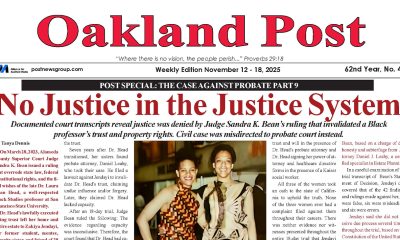Chicago Crusader
Reproductive Health Act passes after emotional debate, narrow vote
CHICAGO CRUSADER — Lawmakers on Tuesday narrowly approved a bill overhauling Illinois’ abortion statute after more than two hours of debate that was passionate and, at times, emotional. The Reproductive Health Act would replace the state’s current law with one backers and detractors agree would be the most liberal reproductive health statute in the nation.
By Rebecca Anzel
Liberal overhaul of abortion law advances to Senate
Lawmakers on Tuesday narrowly approved a bill overhauling Illinois’ abortion statute after more than two hours of debate that was passionate and, at times, emotional.
The Reproductive Health Act would replace the state’s current law with one backers and detractors agree would be the most liberal reproductive health statute in the nation.
It creates access to contraception, pregnancy benefits, abortion procedures, diagnostic testing and other related health care as a fundamental right, banning government from impairing access to those things for women and men.
The bill now moves to the Senate. Melinda Bush, a Democratic senator from Grayslake and the act’s sponsor in that chamber, said Monday she thinks it will succeed there. A committee hearing is expected soon.
Democratic Governor J.B. Pritzker has vowed to “make Illinois the most progressive state in the nation for access to reproductive health care.” He said in a statement Tuesday he looks “forward to continuing my work as an ally by signing the Reproductive Health Act into law.”
The legislation’s passage comes as a hard-fought triumph for its sponsor, Chicago Democratic Representative Kelly Cassidy. She said after months of working to advance this initiative down a path that at times has “not been very easy,” she is “very pleased” at its success.
Cassidy said she is also feeling “relief, just relief that this step is over and that we are poised to affirm our support for reproductive freedom in Illinois and intentionally stand out from all these other states that are attacking women’s rights.”
The General Assembly’s lack of action on the measure harmed Illinois women, she added.
“I think people have a false sense of security around these issues when the reality is that women are in real danger in Illinois as the result of our inaction,” Cassidy said at the beginning of the month.
The final vote was close — there were 64 Democrats voting in favor, 50 legislators from both parties voting no and four Democrats voting present. 60 votes were needed to pass the act successfully.
Advocates were trying to change minds and secure a favorable outcome right up until the vote. Several sources said Pritzker spoke to lawmakers Tuesday morning about why the tenets of the legislation were important to him.
Representative Maurice West, a Rockford Democrat said, “My ancestors had physical chains and laws that governed their bodies. We fought a civil war because we wanted to keep Black bodies chained and enslaved, and now you’re asking me, a Black man, to put policy chains on a woman’s body, on reproductive health …,” he said.
“But now we’re living in a time where government is trying to take away basic freedoms, personal choice, and that worries me more than the threats to my life or the promised curses on my life — I’ll handle those. I know how to pray against those,” West continued. “At this time, I’ve decided to trust women to do what’s best for themselves.”
Recent passage of abortion restriction laws in states such as Alabama, Georgia, Missouri and Ohio spurred the measure to get a second life this session. Legislation in some of those states was advanced, in part, to challenge the 1973 U.S. Supreme Court case Roe v. Wade, which legalized abortion procedures nationwide.
“This vote makes it clear that Illinois women will always have the right to make their own medical decisions – regardless of what [President] Donald Trump, his right-wing judges and extreme politicians in other states do,” House Speaker Michael Madigan, a Chicago Democrat, said in a statement.
The bill mandates private insurance companies regulated by the state must cover abortion procedures if they also provide coverage for pregnancy benefits. One of the changes to this most recent version of the legislation allows companies to employ cost-sharing provisions, such as co-payments, but only if it does so for pregnancy-related coverage as well.
The measure repeals several aspects of current law that courts have blocked, including criminal penalties for doctors and spousal consent.
A Senate panel is expected to hear debate on the bill soon, as the scheduled end of session was May 31.
This article originally appeared in the Chicago Crusader.
Activism
How the Black Press Told the World About Emmet Till
Reporter Simeon Booker and photographer David Jackson covered the story for Jet. Other Black news outlets, including the Defender, also later published the photos, though not a single mainstream white outlet did, according to the New York Times. The photos turned Till’s story into “the first great [national] media event of the civil rights movement,” according to historian David Halberstam, who chronicles the murder in his book “The Fifties.”

By Brandon Patterson
The story of Emmet Till has made its way back into the news in recent weeks on the heels of a new TV miniseries and new developments at the federal level.
Earlier this month, the historical docuseries “Mothers of the Movement” premiered on ABC. And last week, the Senate passed a bipartisan bill to posthumously award Emmett Till and his mother, Mamie Till-Mobley, the Congressional Gold Medal.
Emmett Till’s story remains with us to this day, but lesser known is the role of the Black press in bringing his story to light — and in so doing, helping to catalyze the modern Civil Rights Movement.
One of the earliest news outlets to cover the Till story was the Chicago Defender, at the time one of the most influential Black weekly newspapers in the country, with two-thirds of its readership located outside the city, according to the Chicago Tribune.
The account of reporter Mattie Smith Colin, who covered the arrival of Till’s body at a local train station, captured the anguish of his mother as she received her son. Then, Jet Magazine became the first news outlet to publish the gruesome photos of Till’s body at his funeral, which his mother insisted be open casket.
Reporter Simeon Booker and photographer David Jackson covered the story for Jet. Other Black news outlets, including the Defender, also later published the photos, though not a single mainstream white outlet did, according to the New York Times. The photos turned Till’s story into “the first great [national] media event of the civil rights movement,” according to historian David Halberstam, who chronicles the murder in his book “The Fifties.”
Later, Booker’s coverage of the Till murder trial for Jet helped bring the trial to a Black and national audience. Other significant Black newspapers that covered the Till story included the Amsterdam News in New York City, which, by the 1960s, was the largest weekly community newspaper in the nation, the Pittsburgh Courier, and the Atlanta Constitution.
Coverage of Till’s story was notably different in Black news outlets compared to mainstream white papers. In the South, coverage was often sympathetic to Till’s murderers, notes researcher Michael Oby in a 2007 paper on the Till case.
Black papers, however, framed the story as an obvious and horrid injustice. At the same time, they began encouraging their Black readers to get involved in civil rights organizing, and to donate to the NAACP, which was central to the Till case.
Booker, who worked for Jet for nearly five decades, went on to receive an award from the National Press Club for his lifelong coverage of civil rights in America in the 1980s. At the award ceremony, according to the Chicago Tribune, he said of his work: “I wanted to fight segregation on the front lines. I wanted to dedicate my writing skills to the cause. Segregation was beating down my people. I volunteered for every assignment and suggested more. I stayed on the road, covering civil rights day and night. The names, the places and the events became history.”
Because of his work and other Black journalists and news outlets, we know the story of Emmet Till, and so many other critical stories.
This story was written using reporting from the Chicago Tribune, the New York Times, and academic research by Michael Oby at Georgia State University.
#NNPA BlackPress
NATIONAL DAY OF RACIAL HEALING
CHICAGO CRUSADER — January 21, 2020 is the fourth annual National Day of Racial Healing. The day was established in January 2017 by more than 550 leaders from throughout the United States. All across the country people are marking this day in powerful and moving ways, with events and actions of all kinds.
The National Day of Racial Healing is Tuesday, January 21. Truth, Racial Healing, and Transformation Greater Chicago are bringing together people from throughout the city – concerned citizens, business leaders, faith leaders, nonprofit and government leaders, artists, and community organizers – to kick off a citywide effort to confront and heal from racism.
TRHT Greater Chicago will host 3-days of city wide racial healing circles at community centers, government agencies, nonprofits, schools, corporations, and more. Racial healing circles are designed to raise awareness, consciousness and empathy among those who participate.
January 21-23, 2020
Various locations. Visit website for more information.
Sign up to host a circle (organizations)
Sign up to participate in a circle (individuals)
RSVP to attend the NDORH culmination event – Solidarity Heals CommUNITY Celebration featuring guest speakers and musical entertainment, by Chicago’s own Funkadesi.
January 21, 2020 is the fourth annual National Day of Racial Healing. The day was established in January 2017 by more than 550 leaders from throughout the United States. All across the country people are marking this day in powerful and moving ways, with events and actions of all kinds.
So many of the problems plaguing Chicago – violence, troubled schools, health, wealth and opportunity gaps – are rooted in racism that is embedded in our city’s history. The dehumanization of people of color throughout our city’s past and present has caused forced separation, racial inequity, and injustice that impacts our economy, neighborhoods and relationships. This racism is so obvious to some, but not to others.
Racial healing recognizes the need to acknowledge and tell the truth about past wrongs created by individual as well as systemic racism and address the present consequences. We believe it is essential to pursue racial healing prior to making change work in a community. Because, before we can transform systems and structures, we must do the work on ourselves/our people FIRST.
This article originally appeared in The Chicago Crusader.
#NNPA BlackPress
IN MEMORIAM: Garth C. Reeves, Sr., Retired Miami Times Publisher, Dies
CHICAGO CRUSADER — Regarded as a titan in the Black Press, Reeves was widely respected in Miami for using his power and influence to advance the agenda of the city’s Black community. After experiencing the pain and humiliation of segregation in parks, schools and the U.S. military, Reeves grew into an uncompromising crusader who smashed racial barriers in some of the most prominent organizations in Miami and the nation.
By Erick Johnson, Chicago Crusader

Garth C. Reeves, Sr., The Miami Times’ retired publisher who became the enduring patriarch of a family newspaper dynasty after decades of fighting the political establishment and while guiding the Black community through the city’s racial problems, died on Monday, November 25. He was 100.
Regarded as a titan in the Black Press, Reeves was widely respected in Miami for using his power and influence to advance the agenda of the city’s Black community. After experiencing the pain and humiliation of segregation in parks, schools and the U.S. military, Reeves grew into an uncompromising crusader who smashed racial barriers in some of the most prominent organizations in Miami and the nation.
During his lifetime, Reeves’ newspaper got a police chief fired, ended the career of a a Miami Mayoral, supported a boycott that cost Miami Beach’s tourism industry millions, and unapologetically called riots “protests” or rebellions. He stared down Miami’s political establishment that for decades had been accused of shutting out Blacks in government as Hispanics rose to power in the city’s political and business establishments.

He urged his journalists to write from a Black perspective, one that saw the struggle through a different lens than white newspapers.
His newspaper career spanned at least eight decades. At the height of Reeves’ leadership, The Miami Times earned the name, “The Voice of Miami’s Black Community.” One of the last great Black publishers, Reeves’ death closes a significant chapter in The Miami Times’ illustrious history.
Reeves was born February 12, 1919 in Nassau, Bahamas. That same year, Reeves’ father, Harry Ethelbert Sigismund Reeves, moved to Miami where he founded the Magic Printing Company in Overtown, the city’s historic Black, once-thriving neighborhood near downtown. Harry Ethelbert Sigismund Reeves in 1920 founded the Miami Sun, which closed because of a paper shortage during World War I. In 1923, The Miami Times was founded. Reeves was just four years old.
Garth C. Reeves, Sr. was among many Blacks who attended Miami’s esteemed Booker T. Washington Senior High School, the city’s oldest predominately Black high school that was built when students of color were not accepted at white public schools. Black students at Booker T. were given secondhand text books and football gear that came from white schools.

In 1923, Harry Reeves started The Miami Times at NW 8th Street and 3rd Avenue. It would move four more times in the Overtown neighborhood. When Interstate-95 was built through Overtown, it displaced thousands of Blacks. Many fled north to the Liberty City community, where The Miami Times sits at its present location, 900 NW 54 Street.
In 1940, Reeves graduated from Florida A&M University, a major, historically Black school in Tallahassee, FL. In 1942, Reeves was drafted to serve in the Army during World War II. During an interview in 1999, Reeves recalled a trip on a train to the Pacific coast to go overseas. Despite repeated requests, a white train conductor refused to give Reeves something to eat in spite of him having meal coupons. Reeves went to the military police, who told him to do what the white conductor said, or face being locked up on the train. Reeves was forced to pay for his meal because he could not go into the segregated dining car.
Experiences like those would fuel Reeves’ passion for Black journalism’s role in exposing racial injustices while advocating for the needs of disenfranchised people of color.
After completing his service in 1946, Reeves returned to The Miami Times. By then, Blacks could not sit at segregated diners downtown. Members of the Klu Klux Klan would often parade through Miami’s bustling downtown. Parks and schools did not accept Blacks either and living conditions among Blacks worsened as slums in Overtown increased.
Reeves joined Reverend Theodore Gibson, the president of the local NAACP Chapter and began leading protests for better conditions for Blacks in Miami. Out of 28 beaches, only Virginia Key Beach was open to Blacks. On November 7, 1957, Reeves led a group of seven Black leaders to Crandon Park, a segregated white beach near Miami. Reeves and the men earlier talked to several county commissioners, saying that as taxpayers they had the right to frequent Crandon Park or any segregated beach. Wearing their bathing suits under their clothes, Reeves and the men took off their slacks and went into the water while several police officers watched. Blacks began frequenting other white beaches after the incident.
Blacks were not allowed to play at city-owned golf-courses in the 1940s. But that changed when Reeves and Gibson filed a lawsuit that went all the way to the U.S. Supreme Court. In a landmark case, Rice v. City of Miami, the Supreme Court ruled that the city could not continue accepting tax money to build and maintain golf courses while denying its use to all residents.
In an interview on the History Miami Museum website, Reeves recalled an experience he had when Dr. Martin Luther King came to Miami during the Civil Rights Movement.
“When Martin Luther King came down, I attended some of his meetings. My friend was a good friend of King’s and I used to attend meetings where he would preach to us about nonviolence. I remember talking to Martin a few times and I said, “Martin, you really believe that if I was somewhere and a white guy spat on my face, you think I would walk away from that? I said I’d try and kill that son of a b—-. He said, ‘That’s why you’ve got to try to learn to control yourself.’ I liked him.”
That was Reeves the activist.

Reeves, as the publisher of The Miami Times, was just as fierce. It was the only job Reeves would have throughout his life. He worked his way up the ranks as columnist, reporter, managing editor, and editor. When Reeves’ father died in 1970, Reeves became publisher.
By then The Miami Times had established itself as the Black newspaper of record.
During the 1960s The Miami Times ran a front-page story advocating for the termination of Miami Police Chief Walter Headly, whose Stop and Frisk policy of searching Blacks lit up racial tensions in the city. Headly was eventually fired and the Times readership grew.
When four Miami police officers were acquitted in May, 1980 of killing Arthur McDuffie, a Black salesman, Blacks took to the streets. White newspapers and local television stations described it as a riot. With Reeves at the helm, The Miami Times called the incident a “protest.” When another Miami police officer was acquitted in 1993 for killing two Black motorists in Overtown, The Miami Times called the civil unrest a rebellion.
There were other highlights under Reeves’ leadership at The Miami Times.
In 1985, Mayor Maurice Ferre lost the Black vote and was defeated in his re-election bid after The Miami Times ran a series of editorials criticizing the mayor for firing Howard Gary, Miami’s first Black city manager.
In 1993, Reeves and The Miami Times published editorials and stories supporting a boycott of Miami Beach hotels that cost the tourism industry millions of dollars.
Black leaders accused county leaders of snubbing Nelson Mandela after they withdrew plans to give him a proclamation and key to the city when the anti-apartheid leader publicly expressed his support for Cuban Dictator Fidel Castro.
The National Bar Association and ACLU were among many organizations that did not bring their conventions to Miami Beach in support of the boycott.
The boycott lasted three years and cost the tourism industry between $20 to $50 million. Mandela was given an official proclamation and the hotel industry implemented programs to boost Blacks in its facilities. Miami Beach got its first Black-owned luxury hotel, the Royal Palm Crowne Plaza.
“It was important that we had a communication outlet to get our message out,” said H.T. Smith, a prominent Miami attorney who spearheaded the boycott. “The mainstream media would not give us any coverage. The Miami Times was essential to the boycott’s success. The boycott would not have been successful without The Miami Times. And our friendship grew as a result of this partnership.”
Former Miami Times executive editor Mohamad Hamaludin, who worked for 15 years at the newspaper, said, “Reeves was a fine gentleman. By the time I got to The Miami Times, he and the staff had already established it as a voice for people who didn’t have a voice.”
Reeves was the first Black to serve on the boards of the Miami-Dade College, Barry University, the Greater Miami Chamber of Commerce, and the United Way of Dade County. He also served as organizing chairman of the board for National Industrial Bank, which was the first integrated bank in the State of Florida.
While serving on many of these boards, Reeves pushed them to hire more Blacks when they were reluctant to do so. As a board member of Miami-Dade College, Reeves threatened to lead a vote to stop doing business with the school’s law firm because it resisted his calls to hire Black attorneys in its offices.
Reeves assisted Crusader Publisher Dorothy R. Leavell in bringing the NNPA Annual Convention to Gary in 1983 after Black political power gained a foothold in the Steel City.
“He believed in the Black Press very deeply,” said Leavell who first met Reeves in 1962. “Whatever he did, he was always on the right side of the battle. He remained a forward thinker to the very end. He was truly one of the last of the great Black publishers from the old school in the Black Press.”
Today, The Miami Times is the oldest and largest Black newspaper in the Southeast. For the past two years it has been named Best Black Newspaper by the National Newspaper Publishers Association (NNPA), which represents over 200 Black newspapers across the country. In 2011, NNPA named Reeves Publisher of the Year. In 2017, Reeves was inducted into the National Association of Black Journalists Hall of Fame.
In 2017, Miami recognized Reeves with an honorary street sign at 6 Street and NW 2 Avenue near the Black Archives History and Research Foundation of South Florida where he was a board member.
Reeves was a life member of the National Association for the Advancement of Colored People, Sigma Pi Phi Fraternity, Inc., Omega Psi Phi Fraternity, Inc., and a founding member of the Episcopal Church of the Incarnation in Miami, Florida.
He was awarded honorary doctorate degrees from the University of Miami, Barry University and Florida Memorial University.
For years, Reeves had provided scholarships to aspiring journalism students at his high school alma mater, Booker T. Washington.
Reeves served for 10 years as president of the Amalgamated Publishers Inc. in New York City, which represented over one hundred African American-owned newspapers throughout the United States. He was also elected to serve two terms as president of the National Newspaper Publishers Association.
He retired in 1994 and assumed the role of publisher emeritus but Reeves remained active as a prominent leader in the Black community.
Reeves outlived both of his children. In 1982, Reeves’ son, Garth C. Reeves, Jr., died of colon cancer when just 30 years old. This past September, Reeves’ daughter, Rachel died at 68. His grandson, Garth Basil Reeves now heads the family newspaper dynasty at just 29.
This article originally appeared in The Chicago Crusader.
-

 Activism3 weeks ago
Activism3 weeks agoOakland Post: Week of November 12 – 18, 2025
-

 Activism4 weeks ago
Activism4 weeks agoOakland Post: Week of November 5 – 11, 2025
-

 Activism2 weeks ago
Activism2 weeks agoIN MEMORIAM: William ‘Bill’ Patterson, 94
-

 Activism3 weeks ago
Activism3 weeks agoHow Charles R. Drew University Navigated More Than $20 Million in Fed Cuts – Still Prioritizing Students and Community Health
-

 #NNPA BlackPress3 weeks ago
#NNPA BlackPress3 weeks agoThe Perfumed Hand of Hypocrisy: Trump Hosted Former Terror Suspect While America Condemns a Muslim Mayor
-

 Bay Area3 weeks ago
Bay Area3 weeks agoNo Justice in the Justice System
-

 #NNPA BlackPress3 weeks ago
#NNPA BlackPress3 weeks agoProtecting Pedophiles: The GOP’s Warped Crusade Against Its Own Lies
-

 #NNPA BlackPress2 weeks ago
#NNPA BlackPress2 weeks agoTrump’s Death Threat Rhetoric Sends Nation into Crisis


















































